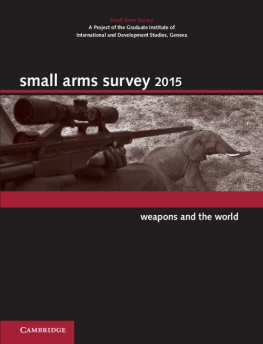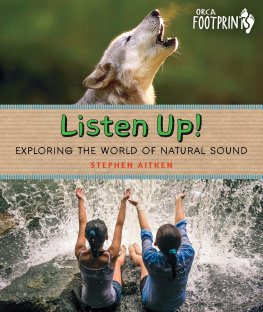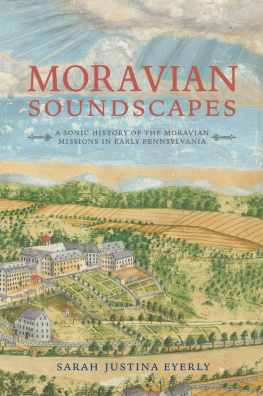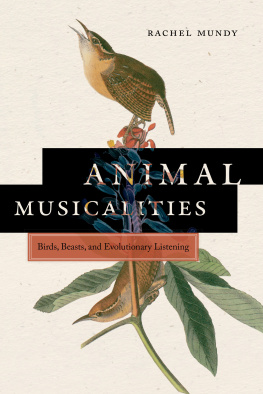
The Birth of the Soundscape
Surrounding our home in rural northern California, the sounds my wife, Katherine, and I have come to know consist of year-round aural traceries of birds, squirrels, amphibians, and insects in the mid-field, the personal conversations we share or the pleading voices of our cats, Barnacle and Seaweed, to be fed or released from indoor bondage to the wider world, the chatter of the TV or the whispered hum of the refrigerator compressor heard from the near field, and the sometimes irritating intrusion of commercial and light aircraft flying overhead combined with the faroff hushed drone of vehicular traffic from two miles (about three kilometers) away in the far field. The daily and seasonal sounds that define Wild Sanctuary, our home, convey a unique sense of place, one weve come to know as much by listening as by seeing.
The phenomenon of the soundscape usually consists of signals arriving from all directions on the horizontal plane and vertically from the sources overheada dome of 3-D sound and combinations of any or all of the three main sources mentioned earlier. Whether were conscious of them or not, were completely surrounded by acoustic elements coming at us from all directions. Active signals generally consist of biophonies and anthropophonies. Passive elements, such as wind and other weather-related signals, make up the rest. The impact of these sounds can be quite pervasive, depending on the environment. Sound, pressure waves transmitted through the air from a source to some type of receiver, can define the boundaries and structural properties of a room, a particular landscape. Of course, acoustic signals are also transmitted through marine environments and other media like wood and metal. The soundscape not only reveals the presence of vocal organisms that inhabit wild biomes, but defines the acoustic detail of floral and geographical featuresthink of the effects of wind in the trees or grasses, or water flowing in streams and by the lake or seashore. Soundscapes also expose the imbalance sometimes caused by changes in the landscape due to human endeavor or natural causes such as invasive organisms, weather, or movement of the land. One of my lifelong interests has been to find new ways to read, comprehend, and express these sources of information.
In 1939, a German ecologist named Carl Troll proposed using aerial photography as a measurement tool to determine relationships between ecosystems. Schafers idea of the soundscape defines events as all the audio signals that reach our ears at any given time. The same goes for the acoustic receptors of non-human creatures. With the introduction of new descriptive language, such as geophony, biophony, and anthropophony, I was able to flesh out in greater detail the basic sources of sound. We have now cleared a path for a range of understanding in both science and culture that leads to fresh ways of experiencing and understanding the living world.
Even before the appearance of rangeomorphs, thought to be the worlds first living marine organisms that evolved off what is now the coast of Newfoundland some 550 million years ago, there was still sound. But there was nothing living that was capable of receiving or responding to it. The wind still whistled and water still trickled along meandering paths. There was also the complex sound of volcanoes shaking the earth and filling the skies with ash. Then the sound of lava flows, landslides, glacial ice cracking and calving, ice in rivers and lakes breaking up in the spring, mudpots, and geysers. The extremes of weather-related conditions produced other acoustic dynamics, adding texture to the still unheard soundscape.
When organisms that could produce and receive sound first appeared, each type evolved to establish a clear bandwidth in the geoacoustic spectrum for its vocal behavior to be functionalthese organisms needed sound-free channels in order to exchange vital information. At first, the sounds they produced were probably impulse-like signatures, more or less like static or short pops and cracks meant to be loud enough in amplitude that they could be sent and received above the levels produced by the surrounding geophonic ambience. Although tiny insect-like marine organisms have developed to generate some of the loudest sounds on the planet (relative to their size), researchers do not generally think that the earliest vocal organisms could communicate beyond a range of a few centimeters. As organisms grew more sophisticated, numerous, land-based, and complex, their sound-producing and receiving capacities also became more efficient. Unique species created unique acoustic expressions, acoustic signatures. Crickets stridulate by rubbing their wings togetherone with a kind of file-type apparatus and another with a scraper. Fish resonate their air bladders, crunch at coral, or oscillate their caudal fins at rates that generate underwater signals. Crabs snap exoskeleton claws. Ants either strike branches with their bodies to transmit sound signals throughout a tree or they stridulate by rubbing their legs on their abdomens. Barnacles twist in tiny shells, birds push air through syrinx-like organs, snakes expel air quickly to hiss, dolphins project highly focused signals through melon-shaped organs, kittens and lions vibrate muscles in their throats to purr and roar. But when living organisms became more numerous and began to fill acoustic niches in their respective habitats, their voices necessarily had to adapt through partitioning, so that each one could transmit and receive signals unimpeded in the specific time or range necessary for their survival. Efficient uses and conservation of energy were paramount.
Some of these observations can lead to astounding correlations. For example, thunderstorms that occur with great frequency in the equatorial regions of the planet give off electrical signals that are then transmitted through the earths magnetic field to the north and south poles. Low-frequency radio receivers such as those used by NASA can detect and record these signals. When played back, they sound like long, extended ascending and descending glissandos produced in early analog synthesizer performances of the mid-1960s. There is nothing particularly unusual about those phenomena. What is curious are the remarkably similar vocalizations produced, in turn, by Weddell seals (Leptonychotes weddellii) in the Antarctic, and bearded seals (Erignathus barbatus) some 12,000 miles to the north, in the Arctic. Their respective vocalizations not only closely replicate the signals detected by the NASA radio receivers, but theyre similar to each other even though the two species have never met.


Though such claims still need substantiation, some animal physiologists, like the late Frank Awbrey, a marine biologist from San Diego State University, have suggested that a small amount of magnetite in the heads of both species may give them the capacity to receive these electronic signals and imitate them, much like the anecdotal stories of people picking up faint radio signals through the silver (amalgam) fillings in their teeth.
During the Pleistocene, when humans first populated African habitats, we added our range of voices to the biophonic mix. As skillful mimics, we first learned to emulate the complex roars, grunts, rhythms, melodies, and harmonies that we experienced in our respective habitats. The mimicry helped us to play it safe; there was little room for error in our attunement with life around us. It was the closest we came to actual biophonic expression during the course of our evolution. As a small fraction of the larger biological community, we owed tribute and calculated the benefits of deference. The soundscapes of the forests and plains signaled where food was (or wasnt). They provided a necessary voice of the divine that, in turn, delivered answers to ontological questions we otherwise had little capacity to solve. They inspired us to organize sound into complex patterns, reflecting those heard in natural settings, which culminated in the first expressions of music and dance, and probably even language. They nurtured us with pulses and cycles of reassuring sonic textures that calmed and centered usthat confirmed our place in the living world. And the biophonies also served as an aural GPS, signals that guided us to remote locations under the cover of total darkness and through the densest foliage with extraordinary precision.

















